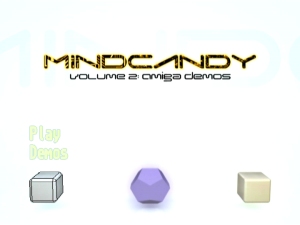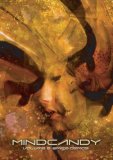| Reviews & Columns |
|
Reviews DVD TV on DVD Blu-ray 4K UHD International DVDs In Theaters Reviews by Studio Video Games Features Collector Series DVDs Easter Egg Database Interviews DVD Talk Radio Feature Articles Columns Anime Talk DVD Savant Horror DVDs The M.O.D. Squad Art House HD Talk Silent DVD
|
DVD Talk Forum |
|
|
| Resources |
|
DVD Price Search Customer Service #'s RCE Info Links |
|
Columns
|
|
|
MindCandy Volume 2: Amiga Demos

Though I never owned or operated an Amiga, I grew up during the era and always remembered having a computer in the house. The flagship Amiga 1000 was released in 1985, a mere four years after MTV hit the airwaves and the same year that the Nintendo Entertainment System debuted in America (though the original Japanese Famicom was introduced some two years earlier). Produced by Commodore International after their purchase of the fledgling Amiga Corporation, the Amiga 1000 boasted strong performance for its time and an advanced operating system that allowed multitasking. Many computer enthusiasts recognized the 1000 as a solid upgrade from the Commodore 64, not to mention a less expensive alternative to the Apple Macintosh. More advanced models would follow in the years to come, culminating in the release of the Amiga 4000 in 1992.
Commodore filed for Chapter 11 bankruptcy in 1994, though the Amiga community continued to support the commercially abandoned product line. Popular Amiga-centric publications continued to see print for the next few years (including "Amiga Format" and "Amazing Computing"), while those looking for nostalgia fixes made frequent use of emulators and the like. Still, a devout section of Amiga disciples continue to own and operate their original machines, pushing the boundaries of the 'outdated' technology; in more ways than one, this degree of loyalty shows that a good enough product always outlasts slick marketing.
Likewise, MindCandy Volume 2: Amiga Demos offers further proof that fans of the company are still vocal supporters. Comprised of 30 "demos" (real-time music videos) created between 1989 and 2004, these tasty visual nuggets offer sufficient proof that you don't need the latest technology to create something new and exciting. All 30 demos were created on various Amiga models and shown at competitive events over the years---and just to satisfy the purists, they were captured to DVD using Amigas as well (without emulation, according to the production crew). Some follow slightly abstract story patterns; others are simple excuses to make the coolest visuals possible. It's an admirable exercise in dedication, even if you weren't part of the scene during the last two decades. Additionally, a few nice bonus features offer further evidence that the demo scene is still alive and kicking.
All 30 included demos are listed below, including the title, production team and major award bestowed upon them. They're helpfully presented in chronological order on this one-disc release, though a number of playing options can help mix things up a bit.
• "Megademo" (Red Sector Inc.) (1st Place, Tristar Party 1989)
• "Mental Hangover" (Scoopex) (1st Place, Swedish Elite Easter Conference 1990)
• "Enigma" (Phenomena) (1st Place, Anarchy Easter Party 1991)
• "Voyage" (Razor 1911) (3rd Place, The Party 1991)
• "Hardwired" (The Silents & Crionics) (2nd Place, The Party 1991)
• "Human Target" (Melon Dezign) (1st Place, Easter Conference 1992)
• "World of Commodore" (Sanity) (2nd Place, World of Commodore 1992)
• "State of the Art" (Spaceballs) (1st Place, The Party 1992)
• "Desert Dream" (Kefrens) (1st Place, The Gathering 1993)
• "Groovy" (Lemon) (2nd Place, The Digital Symposium Party 1993)
• "242" (Virtual Dreams [Fairlight]) (2nd Place, Assembly 1993)
• "9 Fingers" (Spaceballs) (4th Place, The Party 1993)
• "Arte" (Sanity) (3rd Place, The Party 1993)
• "Friday At Eight" (Polka Brothers) (3rd Place, The Gathering 1994)
• "Love" (Virtual Dreams [Fairlight]) (1st Place, South Sealand Party 1994)
• "Nexus 7" (Andromeda) (1st Place, The Party 1994)
• "Deep - The Psilocybin Mix" (CNCD & Parallax) (2nd Place, Scenario 1995)
• "Closer" (CNCD) (1st Place, The Party 1995)
• "Tint" (The Black Lotus) (1st Place, The Gathering 1996)
• "Sumea" (Virtual Dreams [Fairlight]) (1st Place, Assembly 1996)
• "Captured Dreams" (The Black Lotus) (1st Place, The Gathering 1997)
• "Killer" (CNCD) (2nd Place, The Party 1997)
• "Relic" (Nerve Axis) (1st Place, Assembly 1998)
• "Smokebomb" (Ozone) (3rd Place, Mecca & Symposium 1999)
• "Klone" (Dual Crew - Shining) (2nd Place, Assembly 1999)
• "Concrete" (Ephidrena) (1st Place, The Party 1999)
• "Perfect Circle" (The Black Lotus) (1st Place, Mecca & Symposium 2001)
• "Lapsuus" (Maturefurk) (1st Place, Assembly 2001)
• "Fate Fits Karma" (Madwizards) (2nd Place, Breakpoint 2003)
• "Silkcut" (The Black Lotus) (1st Place, Breakpoint 2004)
Presented their original aspect ratios (most of which appear to be 1.33:1 and picture-boxed), MindCandy Volume 2 looks surprisingly good from start to finish. As mentioned earlier, these digital demos were ported to DVD using original Amiga machines, so there isn't much room for improvement here. The bonus features inform us that it took a great deal of work to get all 30 running smoothly and glitch-free, so the end result should certainly please Amiga purists.
Audio is presented in the original stereo mixes, as well as newly-created 5.1 tracks from the original source elements---and since this is largely a music-driven affair, every note comes through clearly. The latter option is especially enveloping, often making good use of the subwoofer and rear channels, though the original 2.0 tracks should satisfy demo enthusiasts. Optional subtitles in a variety of languages (English included) are provided for the accompanying audio commentaries.


Also included is "Demoscene: Portrait of a Party" (19 minutes), a fly-on-the-wall look at the Breakpoint 2004 celebration in Europe. The second annual outdoor festival (celebrating its fifth anniversary this year) is littered with tents, fans, Amigas and high-powered heating units, though the latter couldn't always stand up to the chilly German weather. The footage of demo creators hanging out is certainly expected, but it's also nice to a glimpse of new projects being shown and appreciated. A more retrospective history of events would've been preferable, but this is the next best thing.
Brimming with creativity and enthusiasm, MindCandy Volume 2: Amiga Demos continues the trend of older technology being pushed to the limit. These 30 demos encompass a good cross-section of programming ingenuity over the past two decades, paying as much respect to earlier efforts as the most recent spectacles. The production team has done a fine job on this DVD (which apparently has been four years in the making), keeping the A/V presentation pure while adding experimental sound mixes and a few interesting playback features. Additionally, the bonus features support the main features well, especially the individual audio commentaries from the creators and fans. Overall, it's a fine release that fans should appreciate, though Amiga outsiders may be satisfied with a weekend rental. Recommended.
Randy Miller III is an affable office monkey based in Harrisburg, PA. He also does freelance graphic design projects and works in a local gallery. When he's not doing that, he enjoys slacking off, second-guessing himself and writing things in third person.
|
| Popular Reviews |
| Sponsored Links |
|
|
| Sponsored Links |
|
|
| Release List | Reviews | Shop | Newsletter | Forum | DVD Giveaways | Blu-Ray | Advertise |
|
Copyright 2024 DVDTalk.com All Rights Reserved. Legal Info, Privacy Policy, Terms of Use,
Manage Preferences,
Your Privacy Choices | |||||||












